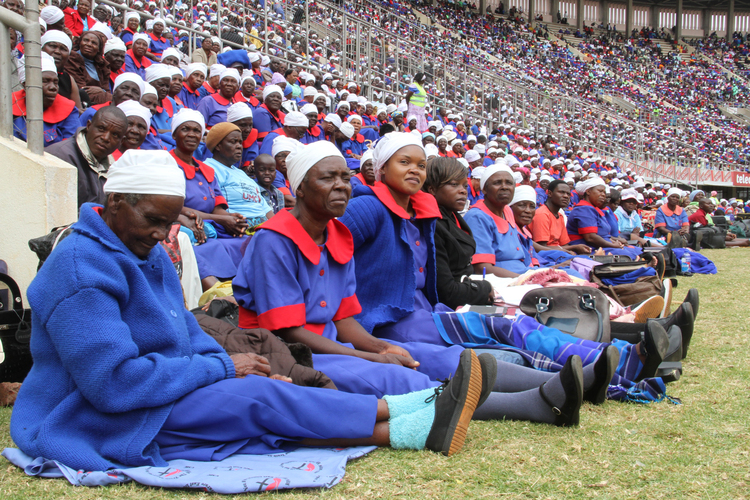
The Sunday Mail

Attending a church service as a visitor is bound to make some people feel out of place as church members in most churches are easily identified with their uniforms.

Uniforms are a form of identity and discipline but if worn by people who are not aware of its purpose it can be a source of divisions. Pictures by Kudakwashe Hunda
Is a church uniform really that important for a soul that is seeking salvation? What exactly is the significance of these uniforms?
The culture is mainly rooted in the traditional mainline churches such as Anglican, United Methodist, Methodist Church in Zimbabwe, Roman Catholic and Presbyterians, among many others. Most apostolic sect members wear white garments. However, evangelical and pentecostal churches have also developed the culture of wearing uniforms, especially during particular functions.
Seventh Day Adventist church national education director, Pastor Felix Njini said the colour of the uniforms does not have any significance.
“We are a global church but we don’t have a global uniform. You will find that here in Zimbabwe SDA women wear green and purple uniforms while in Zambia they wear blue. In South Africa they put on black and white.
“Our identity as a church is not in the uniform but in our mission,” explained Pastor Njini.
SDA men wear white shirts, black trousers and blue neckties. A logo is emblazoned on the neckties.
However, Methodist Church in Zimbabwe National education secretary, Reverend Elliot Mashonganyika said church uniforms carry great significance.
“Members of the Men Christian Union (MCU) are baptised and receive the confirmation (kusimbiswa). They put on red jackets, black trousers and black shoes. The women (Ruwadzano) put on white hats, red blouses with a white collar and red belt together with a black skirt and matching shoes.
“On the occasion of the initiation, the women are assisted to put on their uniforms for the first time by the pastor’s wife. Vanoita zvekupfekedzwa naMai mufundisi.
“The red signifies the sin we were in before the blood of Jesus cleansed us to become white, that is what the white colour stands for.
“The buttons on the ladies’ blouses must be five, thereby representing Christ’s five wounds on the cross.
“Anyone can also put on the other uniform that has church logos all over. For that one, baptism and conformation is not a pre-requisite,” Rev Mashonganyika explained.
However, wearing particular colours in the MCZ has got connotations.
“In our church, if you are a second wife you are not allowed to wear the red and white uniform, unless if your husband is divorced or widowed. The red and white uniform is reserved for first wives,” said Mrs Anesu Mauluka, a member of the MCZ, better known as Hwisiri.
In the Catholic church, there are different uniforms for guilds such as St Joseph, St Anne and St Mary, among others.
According to the Catholics, a member within a particular guild will wear that guild’s uniform and is expected to live according to the standards set by a particular saint.
A Catholic member who preferred anonymity said if uniforms are worn by people who are not well catechised, they can be a source of divisions.
“If worn by people with selfish motives, it destroys the church.
“You find that members from different guilds do not want their activities jeopardised by activities of another.
As a result, competition develops among these guilds,” said the Catholic member.
The member said that the issue of uniforms has divided people in some regions.
“Some of these things become regional. You will find that a certain guild with a certain uniform colour has become dominant among the Zezuru, Kalangas or Ndebeles. At the end of the day, people are identified that way. This also marginalises those who are not from those tribes or regions.”
Bishop Marvellous Mhloyi of Revival United Church of Christ said that for everything that is meant to be good, bad things always arise, even among Christians.
“The army has its uniform, it is a discipline, a body of people who follow certain rules. Even schools have uniforms, its uniformity.
“Having a uniform in church camouflages differences between Christians. You find that in some churches that do not have uniforms, some members can wear very expensive clothes while their less privileged counterparts can be washing and wearing the same clothes again and again. This can discourage the less privileged members. Uniforms therefore, covers these differences and equates them,” explained Bishop Mhloyi.
She added that a uniform carries identity and dignity, hence one’s behaviour is controlled when donning such cloth.
“Even uniformed forces are expected to remove their uniforms first if they want to engage in personal social activities. Similarly, church members should also respect the uniforms they wear,” added Bishop Mhloyi.
◆ Email feedback at [email protected]



